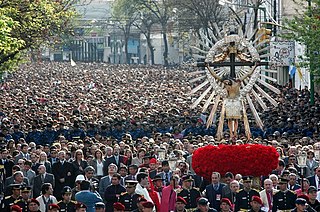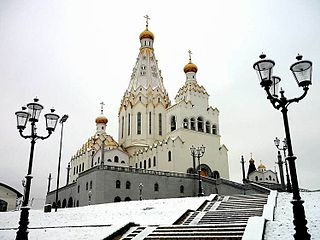Related Research Articles
Antisemitism in Christianity, a form of religious antisemitism, is the feeling of hostility which some Christian Churches, Christian groups, and ordinary Christians have toward the Jewish religion and the Jewish people.

The persecution of Christians can be historically traced from the first century of the Christian era to the present day. Christian missionaries and converts to Christianity have both been targeted for persecution, sometimes to the point of being martyred for their faith, ever since the emergence of Christianity.

Sephardic or SephardiJews, also Sephardim or PeninsularJews, are a Jewish diaspora population associated with the Iberian Peninsula. The term, which is derived from the Hebrew Sepharad, can also refer to the Mizrahi Jews of Western Asia and North Africa, who were also influenced by Sephardic law and customs. Many Iberian Jewish exiles also later sought refuge in Mizrahi Jewish communities, resulting in integration with those communities.

Christianity is the most widely professed religion in Argentina, with Roman Catholicism being its largest denomination. This historical background is very much due to the Spanish influence brought about through the newly conquered territories. However, affiliation with Protestant churches is increasing and immigration throughout the 20th century has brought other religions from various regions to Argentina.
"Who is a Jew?" is a basic question about Jewish identity and considerations of Jewish self-identification. The question pertains to ideas about Jewish personhood, which have cultural, ethnic, religious, political, genealogical, and personal dimensions. Orthodox Judaism and Conservative Judaism follow Jewish law (Halakha), deeming people to be Jewish if their mothers are Jewish or if they underwent a halakhic conversion. Reform Judaism and Reconstructionist Judaism accept both matrilineal and patrilineal descent as well as conversion. Karaite Judaism predominantly follows patrilineal descent as well as conversion.
New Christian was a socio-religious designation and legal distinction in the Spanish Empire and the Portuguese Empire. The term was used from the 15th century onwards primarily to describe the descendants of the Sephardic Jews and Moors baptised into the Catholic Church following the Alhambra Decree. The Alhambra Decree of 1492, also known as the Edict of Expulsion, was an anti-Jewish law made by the Catholic Monarchs upon the Reconquista of the Iberian Peninsula. It required Jews to convert to Catholicism or be expelled from Spain. Most of the history of the "New Christians" refers to the Jewish converts, who were generally known as Conversos while the Muslim converts were known as Moriscos.

The Rhineland massacres, also known as the German Crusade of 1096 or Gzerot Tatnó, were a series of mass murders of Jews perpetrated by mobs of French and German Christians of the People's Crusade in the year 1096, or 4856 according to the Hebrew calendar. These massacres are often seen as the first in a sequence of antisemitic events in Europe which culminated in the Holocaust.
Jewish population centers have shifted tremendously over time, due to the constant streams of Jewish refugees created by expulsions, persecution, and officially sanctioned killing of Jews in various places at various times. In addition, assimilation and forced conversions have also impacted Jewish population sizes throughout Jewish history.
The Catholic Church and Judaism have a long and complex history of cooperation and conflict, and have had a strained relationship throughout history, with periods of persecution, violence and discrimination directed towards Jews by Christians, particularly during the Middle Ages.

Religion in Europe has been a major influence on today's society, art, culture, philosophy and law. The largest religion in Europe is Christianity, but irreligion and practical secularisation are strong. Three countries in Southeastern Europe have Muslim majorities. Ancient European religions included veneration for deities such as Zeus. Modern revival movements of these religions include Heathenism, Rodnovery, Romuva, Druidry, Wicca, and others. Smaller religions include Indian religions, Judaism, and some East Asian religions, which are found in their largest groups in Britain, France, and Kalmykia.

Christians in Morocco constitute less than 1% of the country's population of 33,600,000. Most of the Christian adherents are Catholic and Protestants.
Forced conversion is the adoption of a different religion or the adoption of irreligion under duress. Someone who has been forced to convert to a different religion or irreligion may continue, covertly, to adhere to the beliefs and practices which were originally held, while outwardly behaving as a convert. Crypto-Jews, crypto-Christians, crypto-Muslims and crypto-Pagans are historical examples of the latter.
Growth of religion involves the spread of individual religions and the increase in the numbers of religious adherents around the world. In sociology, desecularization is the proliferation or growth of religion, most commonly after a period of previous secularization. Statistics commonly measure the absolute number of adherents, the percentage of the absolute growth per-year, and the growth of converts in the world.

Christianity is a minority religion in Yemen. The Yemeni constitution mentions religious liberty. There are three churches in Aden.

Christianity is the most prevalent religion in the United States. Estimates from 2021 suggest that of the entire U.S. population about 63% is Christian. The majority of Christian Americans are Protestant Christians, though there are also significant numbers of American Roman Catholics and other Christian denominations such as Latter-day Saints, Orthodox Christians and Oriental Orthodox Christians, and Jehovah's Witnesses. The United States has the largest Christian population in the world and, more specifically, the largest Protestant population in the world, with nearly 210 million Christians and, as of 2021, over 140 million people affiliated with Protestant churches, although other countries have higher percentages of Christians among their populations. The Public Religion Research Institute's "2020 Census of American Religion", carried out between 2014 and 2020, showed that 70% of Americans identified as Christian during this seven-year interval. In a 2020 survey by the Pew Research Center, 65% of adults in the United States identified themselves as Christians. They were 75% in 2015, 70.6% in 2014, 78% in 2012, 81.6% in 2001, and 85% in 1990. About 62% of those polled claim to be members of a church congregation.

Christianity is the main religion in Belarus, with Eastern Orthodoxy being the largest denomination. The legacy of the state atheism of the Soviet era is evident in the fact that a part of the Belarusians are not religious. Moreover, other non-traditional and new religions have sprung up in the country after the end of the Soviet Union.
Christian population growth is the population growth of the global Christian community. According to a 2011 Pew Research Center survey, there were more than 2.2 billion Christians around the world in 2010, more than three times as many as the 600 million recorded in 1910. However, this rate of growth is slower than the overall population growth over the same time period. In 2020, Pew estimated the number of Christians worldwide to be around 2.38 billion. According to various scholars and sources, high birth rates and conversions in the Global South were cited as the reasons for the Christian population growth. In 2023, it was reported: "There will be over 2.6 billion Christians worldwide by the middle of 2023 and around 3.3 billion by 2050, according to a report published in early January by the Center for the Study of Global Christianity at Gordon Conwell Theological Seminary."
The main religion in Morocco is Sunni Islam, which is also the state religion of the country. Blasphemy against Islam is a punishable offense. Officially, 99% of the population are Muslim, and virtually all of those are Sunni. The second-largest religion in the country is Christianity, but most Christians in Morocco are foreigners. There is a community of the Baháʼí Faith. Only a fraction of the former number of Maghrebi Jews have remained in the country, many having moved to Israel.
References
- 1 2 3 François., Soyer (2007). The persecution of the Jews and Muslims of Portugal : King Manuel I and the end of religious tolerance (1496-7). Leiden: Brill. ISBN 9789047431558. OCLC 311601500.
- ↑ Abraham Joshua Heschel, Joachim Neugroschel, Sylvia Heschel (1983). Maimonides: A Biography. Macmillan. p. 43.
{{cite book}}: CS1 maint: multiple names: authors list (link) - ↑ Lea, Henry Charles (January 1896). "Ferrand Martinez and the Massacres of 1391". The American Historical Review. 1 (2): 209–219. doi:10.2307/1833647. ISSN 0002-8762. JSTOR 1833647.
- ↑ Pérez, Joseph (2012). History of a Tragedy. p. 17.
- ↑ Dominic Lieven, ed. (2006). The Cambridge History of Russia: Volume 2, Imperial Russia, 1689-1917. Cambridge University Press. p. 186.
- 1 2 "CONVERTS TO CATHOLICISM, MODERN - JewishEncyclopedia.com". www.jewishencyclopedia.com. Retrieved 2017-09-25.
- ↑ Picciotto, James (1875). Sketches of Anglo-Jewish history. University of California Libraries. London : Trübner & Co.
- ↑ Rabbi Abraham Geiger, "Vor Hundert Jahren," Brunswick, 1899
- ↑ "Jews, Missions to the". www.ccel.org. Retrieved 2017-09-25.
- ↑ “Missionsblatt des Rheinisch-Westphälischen Vereins für Israel," 1878, p. 122
- ↑ Johannes Friedrich Alexander de le Roi, "Die Evangelische Christenheit und die Juden," iii. 60
- ↑ Johann Jakob Herzog (1882). Real-Encyklopädie für protestantische Theologie und Kirche. [With] Generalregisterband. Unter ... (in German). Oxford University. Leipzig, J.C. Hinrichs. pp. x. 114.
- ↑ "STATISTICS - JewishEncyclopedia.com". www.jewishencyclopedia.com. Retrieved 2017-09-25.
- ↑ Dalman, Gustaf (1893). Kurzgefasstes Handbuch der Mission unter Israel (in German). Reuther und Reichard. p. 48.
- ↑ “Divre Emeth," 1880, p. 47; 1883, p. 187
- ↑ Hess, Jonathan M. (January 2009). "Review of Hertz, Deborah, How Jews Became Germans: The History of Conversion and Assimilation in Berlin". www.h-net.org. Retrieved 2017-09-25.
- ↑ "How many Jews are there in the United States?". Pew Research Center. 2013-10-02. Retrieved 2017-09-25.
- 1 2 "Chapter 1: Population Estimates". Pew Research Center's Religion & Public Life Project. 2013-10-01. Retrieved 2017-09-25.
- ↑ Maltz, Judy (2013-09-30). "Survey Says American-Jewish Population Rises to 6.8 Million". Haaretz. Retrieved 2017-09-25.
- ↑ "Main page project "Arena"". Non-profit research based consulting "Sreda". 2012-10-19. Retrieved 2017-09-25.
- ↑ 2012 Survey Maps. "Ogonek", № 34 (5243), 27/08/2012. Retrieved 25-09-2017.
- ↑ "Jewish Americans in 2020". Pew Research Center.
That means that one-third of those raised Jewish or by Jewish parent(s) are not Jewish today, either because they identify with a religion other than Judaism (including 19% who consider themselves Christian) or because they do not currently identify as Jewish either by religion or aside from religion.